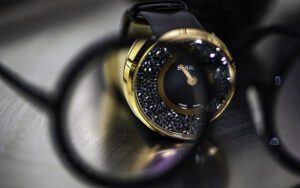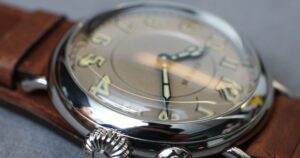Hamilton watches have a long and rich history. The company began as a U.S. pocket watch maker, then evolved into supplying wristwatches before ultimately becoming a Swiss watchmaking company. Hamilton is known for being the watchmaker of choice in military, aviation, and even Hollywood. With a wide range of beautiful and unique designs, Hamilton has a reputation for innovation, precision, and excellence.

American Roots
The Hamilton brand was founded by merging two watchmaking companies, one struggling and the other defunct. When the Keystone Standard Watch Company—based in Lancaster, Pennsylvania—went under in 1891, investors bought out its manufacturing facility and merged it with the floundering Aurora Watch Company. The investors chose the name Hamilton to honor Andrew Hamilton, Lancaster’s original owner, and his son James Hamilton, Lancaster’s original planner.
Railroading Ventures
In 1893, Hamilton released its first collection of pocket watches. Their precise timekeeping made them extremely popular with the American railroad network. Before long, railroads exclusively used Hamilton’s Broadway Limited models to synchronize trains’ timing and avoid crashes.
Before the application of Hamilton pocket watches, rail crashes were relatively frequent. Because of Hamilton’s precision, the brand soon became known as The Watch of Railroad Accuracy. Soon, Hamilton’s reputation spread around the world, and the 992 model became the standard timepiece for American-built railroads in France.
Hamilton in World War I
In the years leading up to the First World War, wristwatches had just entered the scene and were becoming increasingly popular. Hamilton joined the wristwatch fad in 1917, initially producing watches with only two different sizes of movements. (Movements are the engines of a watch.)
However, World War I made the wristwatch a necessity, as soldiers needed something more convenient than pocket watches. Hamilton responded by producing a wristwatch with a size-zero movement, small enough to be worn as a pendant and easily compact enough to be worn on a soldier’s wrist. Hamilton’s wristwatches soon took over, and the pocket watch became obsolete.
Venturing into Flights
With World War I came the advent of the airplane. Once the war ended in 1918, airplane purposes changed from dogfighting to mail transportation. Airmail companies needed a way to keep time, and they knew of one brand that had developed quite a reputation on the rails.
Hamilton, therefore, was chosen to be the official timekeeper of the U.S. airmail service. From there, the brand’s prestige expanded even further, and pilots used Hamilton watches in the first cross-country flight from New York to San Francisco, the first flight to the North Pole, and many other record-breaking flights like the first flight to cross the Pacific from California and land in Hawaii.
Commercial airlines were beginning to develop at this time. By the 1930s, Hamilton had become the official watchmaker for the four major American airlines. After keeping perfect time on the first transcontinental U.S. flight, airlines again chose Hamilton as the official timekeeper of commercial flights from New York to San Francisco.
Military Expansion in World War II
With the onset of World War II, commercial ventures came to a grinding halt. Hamilton, like nearly every other company, stopped commercial production to instead assist with the war effort. Hamilton shipped over 1 million watches overseas to Allied soldiers. The U.S. Army-Navy valued Hamilton’s contribution so highly that they awarded Hamilton an official U.S. Army-Navy “E” award, signifying “Excellence of Production” of war equipment.
Hamilton was so committed to innovation and the war effort that the brand designed a new instrument for testing its chronometers for accuracy. The chronometers that were tested and refined using this instrument were incredibly precise—accurate to 1/100th of a second per day. Hamilton watches even beat out the Naval Observatory’s testing procedures. With such accuracy came little need for soldiers to request watch repairs for their Hamilton models, further impressing the U.S. military.
Hamilton in Hollywood
Once World War II was over, the world could relax. Hamilton was no exception. The brand’s excellent reputation during the war had left its mark, and in 1951, several Hamilton military models appeared in the World War II-themed film The Frogmen, which was nominated for two Academy Awards.
This was not Hamilton’s first appearance on the silver screen, as its watches were also shown in 1932 in the film Shangai Express. However, it would also be far from the last time: Elvis Presley chose to wear the Hamilton Ventura in the 1961 film Blue Hawaii.
The Ventura was not explicitly designed for Blue Hawaii, but its iconic triangle-shaped face left an impression on filmmakers; soon, they were approaching Hamilton to create custom pieces just for their films. Hamilton watches and clocks have since been featured prominently in movies and shows such as 2001: A Space Odyssey, Men in Black, Die Hard, Interstellar, Tom Clancy’s Jack Ryan, and Dune: Part Two.
Several of these films and shows’ plots revolve around timekeeping and using watches, making Hamilton watches more than just Easter eggs featured briefly on the screen. Hamilton has even converted many of these built-for-film watches into timepieces anyone can buy.
Shift to Switzerland
While Hamilton designed watches for film and television, the brand joined Swatch Group—a Swiss manufacturer—in 1974. In doing this, it became a subsidiary of the Swatch Group and joined the ranks of other watchmakers like Omega, Blancpain, Breguet, Harry Winston, Inc., and many other prestigious brands.
This transition eventually led to the relocation of the Hamilton headquarters to Switzerland in 2003. Swiss watches are known for being some of the most beautiful and high-quality watches in the world; by combining Swiss excellence with its American history and reputation for precision, Hamilton has maintained and strengthened its character and influence.
Hamilton Today
Today, Hamilton is known for its strength and reliability. Its watches are not considered luxury timepieces, but when it comes to precision, there won’t be any need for frequent watch repairs—a Hamilton watch will rival any Rolex or Patek Philippe in accuracy.
Hamilton has also continued its close association with airplanes: in 2011, Hamilton officially partnered with Air Zermatt, the Swiss mountain rescue airline and flight school, to produce watches to aid in timing rescue missions.
Most recently, Hamilton announced its partnership in 2022 with Air-Glaciers, an air rescue force based in the Swiss Alps. Air-Glaciers teams use Hamilton watches to ensure reliable timekeeping during their rescue flights.
The precision and excellence that are the driving force behind Hamilton continue to bolster the brand’s reputation. Hamilton watches today are featured so prominently in film, airlines, and military operations that the watchmaking company is known and appreciated worldwide.




